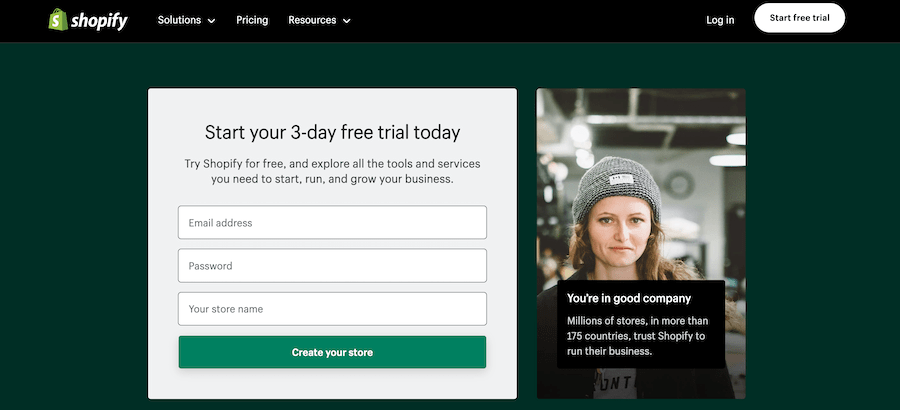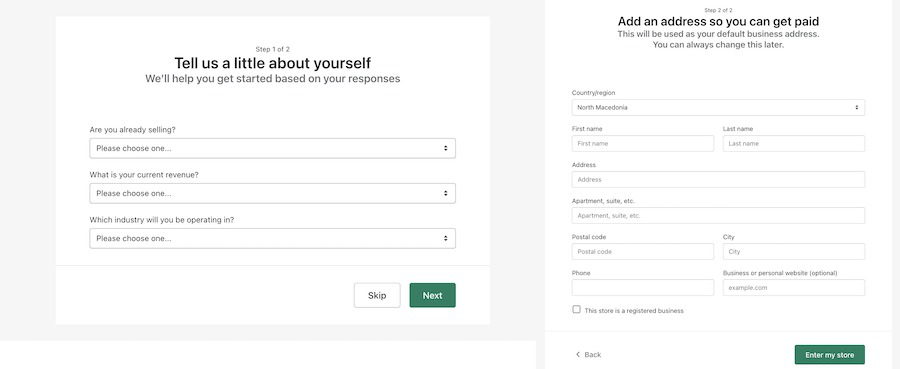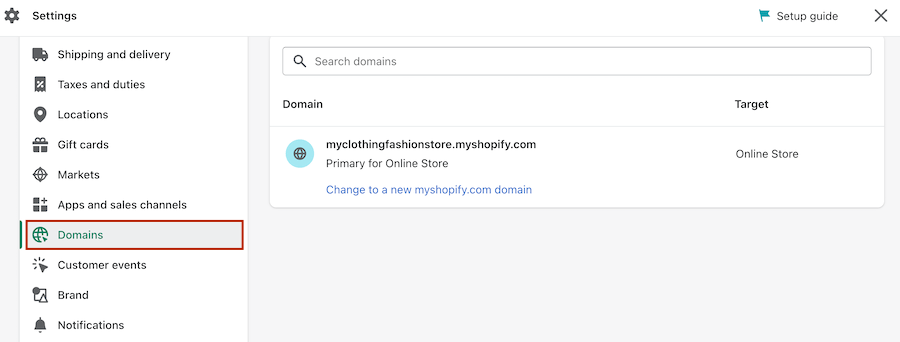The Ultimate Shopify Dropshipping Guide
Dropshipping is currently the hottest business model for entrepreneurs looking to break into the eCommerce industry. The essential pluses that make the method so attractive to the newbies are undoubtedly the fast and easy set-up and management of an online store even without having extensive knowledge in the area. That's why, according to statistics, up to 33% of online stores have chosen dropshipping as their business method.
However, as a beginner on this market, you probably wonder how do dropshippers get their stores live. The answer is: eCommerce platforms. One such platform is the well reputable company Shopify. The platform has grown to be so popular among business owners that in 2022 has generated nearly $US 47 billion.
To get a taste of the success Shopify can bring to your dropshipping store, we’ve put together a complete guide on Shopify dropshipping to help you learn all the details and allow you to run your Shopify business effortlessly.
:format(webp)/https%3A%2F%2Fbrandsgateway.com%2Fapp%2Fuploads%2F2024%2F06%2Fbanner.jpg)
Looking for a reliable dropshipping or wholesale supplier?
Join us today for top-quality products and unbeatable prices.
What is Shopify?
Shopify is a web-building software suitable for all those who plan on opening and managing an online store, including dropshippers. What makes the platform an excellent choice for entrepreneurs of all kind are its beginner-friendly feature, easily manageable interface, and wide broad of building tools.
What advantages dropshipping on Shopify brings?
- User-friendly interface. For the purpose of accommodating both beginners and advanced users, Shopify has developed a super user-friendly interface that can be easily navigated.
- Easy set up. Along with the user-friendly interface, Shopify has also created a bunch of tools enabling users to set up their website within a matter of minutes and get their store live quickly.
- Affordable subscription plans. When it comes to their service payments, Shopify offers a few plans that come with versatile features and can meet different business needs. Most importantly, Shopify’s subscription packages are quite affordable, with their Basic Plan starting at only $32 per month and 2.9% + 30¢ per online transaction.
- Plenty of web-builing features. Shopify let’s you enjoy a large selection of features. Although these can vary from one plan to another, each subscription package is equipped with a basic tool collection that includes unlimited product listings, domain name, free SSL certificate, currency converter, and 24/7 customer support among many others.
How do I start dropshipping on Shopify?
Opening a dropshipping store on Shopify isn’t as complicated as it may look from afar. To give you all the support we can, we’ve break down the process in nine steps so you know the exact order of the building stages and what each of them entails you to do.
STEP 1: Create a Shopify Account
We start by signing up for a Shopify account that comes with a 3-day free trial. Only after its expiration you’ll be required to choose from one of the platform’s pricing plans.
- Go to shopify.com/signup;
- Fill out your email address, password, and your store’s name (if you struggle with the name, on the page for building your brand, you can also generate a business name and create a free logo.);

- Click on “Create your store”;
- Provide the rest of the information the platforms asks for (your niche, business address, current revenue, etc.);
- Click on “Enter my store.”

STEP 2: Customize your online store
Once you’ve chosen a name and a supplier that ensures integration with your Shopify store, you can get your creative juices flowing. Shopify offers free and paid themes for Shopify web design as well as all kinds of pages (Homepage, Product pages, About Us, Contact Us, FAQ, etc.) you can include on your website.
- Go to the side menu;
- Click on “Online Store”;
- Select “Themes” to choose from the best Shopify dropship themes and click on the other fields to further customize your site.

STEP 3: Buy a domain
With some eCommerce platforms, you’ll need to find a hosting service by yourself that’ll take care of your domain. With Shopify you can buy your domain directly from your store without the need of contacting hosting providers.
There are a few options for buying and setting up your online store domain.
First option:
- On your homepage, click on “Settings” and then “Domains”;
- You get to generate a name for your store which will be added to the ‘my.shopifystore.com’ domain – the end result will be your-store-name.myshopify.com.

Second option:
- If you have already bought a domain for your store from a third-party provider, you can transfer it and connect it to your store by clicking on “Connect existing domain.”
Third option
- Purchase a domain from Shopify by clicking on “Buy new domain.”
- You get to keep the domain even if you decide to leave the platform.

STEP 4: Choose your payment options
The next step is deciding which payment options you prefer your customers to be using when making a purchase in your store.
- Open “Settings” on your homepage.
- Click on “Payments” in order to set up your dropshipping payment gateways.
- Choose from third-party payment providers or opt for Shopify approved payment options.

STEP 5: Set up your delivery, store policies, and sales channels
A crucial step in the process of building your Shopify dropshipping store is defining your policies (refunds and returns, shipping, privacy, terms and conditions), choosing your sales channels, and providing general information about your shipping service.
- Open once again the “Settings” menu.
- On the left side, you’ll find the fields “Shipping and Delivery,” Sales channels,” and “Store Policies.”

- To add sales channels, simply click on “Shopify App Store.”

STEP 6: Add your products
Finally, it’s time to insert your products.
- Select “Products” from the menu;
- Go to “Add product”;
- Provide product data such as title, description, shipping info, price, images, price, etc.;
- Click on “Save product.”

STEP 7: Optimize your online store
One of the most important things in setting up a Shopify store is optimizing it. It doesn’t matter if you have the most attractive trending products in your store, if you don’t optimize them, you can lose valuable customers. Shopify got this covered as well.
The platform has ready-made SEO for Shopify dropshipping features that allow you to write your store’s meta title and meta description which are vital for your search engine rankings. In addition, by opening the “Apps” field, you’ll come across a wide variety of apps you can add to your store. You will also find these in the Shopify App Store.

Here are a few apps we highly recommend to give them a go.
Image Optimizer – Image optimization app
- Photo compression tools;
- PNG to JPEG conversion tool;
- Alt text and filename optimization;
- 30-day image backup;
- Free plan and paid plans starting at 5$/month.
Smart SEO – SEO optimization app
- Optimizes meta tags, images, and page speed;
- Access to JSON-LD structured data;
- Detects and fix any broken links automatically;
- Free plan and paid plans starting at 10$/month.
Klaviyo – Email marketing app
- Syncs all your Shopify data;
- Creates audience segmentation based on your target customers;
- Customizable email and SMS templates;
- Free plan and paid plans for 15$/month and 20$/month.
STEP 8: Launch your store
Once you’re sure you’ve got everything ready, you can go ahead and get your dropshipping store online. To make your Shopify store go live, you’ll only need to remove your password:
- Go to the “Online Store”;
- Click on “Preferences”;
- Navigate to “Password Protection”;
- Uncheck “Restrict access to visitors with the password.”

STEP 9: Build your marketing campaign
Although you’ve already launched your Shopify store, you still aren’t off the hook. Now it comes the most challenging part of the whole process which is building your store’s brand working on a killer advertising campaign.
No worries, however, because we still got you covered. Since your store has freshly entered the market, you should start by focusing on a few basic marketing strategies that’ll help you to let customers know about your business’s existence.
- SEO marketing. SEO marketing refers to improving your website by following the SEO guidelines in order to be able to get your site rank high on search engines such as Google. The higher it ranks the bigger the organic traffic. You can do this by making your web structure user-friendly (visitors shouldn’t have to click more than 3 times to get to a certain section), optimizing it for both mobile and desktop, inserting well-written content on each of your pages, and targeting keywords customers are likely to use them searching for the products you sell to name a few.
- Email marketing. Email marketing is a highly effective way to inform customers about any news related to your store, be that discounts, sales, new arrivals, blog posts, etc. by doing so, you have great chances of getting one-time buyers back into your store and drive more conversions.
- Social media marketing. Never underestimate the power of social media. As currently the most preferred type of word-of-mouth marketing, you must make the smart choice of opening social media accounts and plastering your products all over platforms such as Facebook, Instagram, and TikTok.
- Paid advertising. Last but not least, paid advertising is always a great option to invest. Yes, you’ll need to spend some money, but it can still be quite affordable as with the majority of platforms, you can pay as much as you want and can at that moment. Whether you try Google Ads, TikTok Ads, Facebook Ads, or Instagram Ads, you won’t regret it.
Dropshipping with Shopify and BrandsGateway
In order to secure constantly incoming dropshipping sales, it’s best to connect your Shopify with a dropshipping supplier that’ll offer you premium products of the highest quality, seamless customer service, great profit margins, and a fully automated dropshipping system, someone like BrandsGateway.
The process is designed to be pretty simple and easy so everyone could join BrandsGateway and directly import their catalog to their store within a couple of hours. The automation plugin that the company provides ensures smooth integration with all Shopify-based clothing stores. In addition, the plugin’s main benefits include automatic inventory updates and automatic order placement, something every dropshipper would certainly love to benefit from.
BrandsGateway provides customers with convenient Shopify integration that can be done by following only a few steps:
- Register an account at https://brandsgateway.com/register/.
- Open https://apps.shopify.com/brandsgateway-app.
- Click on ‘Add App’ and install BrandsGateway App in your Shopify store.
- Choose a dropshipping package.
- Import BrandsGateway’s product catalog.

Keep learning with Shopify resources
Your journey with Shopify doesn’t end once you’ve set up and launched your online store. Shopify is a platform that not only helps you start your dropshipping business from scratch but also improves and expands it. To support you in building a winning dropshipping business, Shopify has diverse beneficial resources at hand. You can visit courses on Compass and learn how to grow a profitable business, hear e-commerce advice and dropshipping tips on Masters podcasts, read articles, and explore guides on Shopify’s blog.
Shopify comparisons
FAQ
-
If you want to enter the dropshipping industry quickly and safely without losing valuable time on building an online store by yourself, Shopify dropshipping is the solution. Shopify is a user-friendly and easy-to-use platform that includes many built-in features but also offers the possibility of simple integration with diverse third-party tools. In other words, it’s the perfect platform for anyone to open and grow a winning dropshipping business smoothly.
-
Yes, Shopify is quite a user-friendly platform, especially when it comes to beginners to dropshippers that are just getting to know how the business functions.
-
Yes, dropshipping on Shopify is definitely profitable. With over 1,000,000 merchants actively using the platform from over 175 countries worldwide, it speaks volumes about Shopify’s moneymaking nature.
-
Yes, dropshipping on Shopify is completely legal. Keep in mind, nevertheless, that you’ll need to make sure your dropshipping business complies with the rules and regulations of the country you’re operating in and, of course, that you’re working with a reliable dropshipping supplier.
Related articles
Our clients' success stories speak volumes about the impact BrandsGateway has had on their businesses.
View More Articles








:format(webp)/https%3A%2F%2Fbrandsgateway.com%2Fapp%2Fuploads%2F2024%2F07%2FScreenshot_20240618_140550_Gallery.jpg)
:format(webp)/https%3A%2F%2Fbrandsgateway.com%2Fapp%2Fuploads%2F2025%2F03%2Fshopify-chargebacks.jpg)
:format(webp)/https%3A%2F%2Fbrandsgateway.com%2Fapp%2Fuploads%2F2025%2F02%2FChoosing-shopify-pricing-plan-scaled.jpg)
:format(webp)/https%3A%2F%2Fbrandsgateway.com%2Fapp%2Fuploads%2F2024%2F09%2Fluxury-goods.png)
:format(webp)/https%3A%2F%2Fbrandsgateway.com%2Fapp%2Fuploads%2F2024%2F06%2Fpop-up-shop.png)
:format(webp)/https%3A%2F%2Fprod-brandsgateway-images.s3.fr-par.scw.cloud%2F2021%2F05%2Fwomens-clothing-1-aa0164ad-aaa.jpg)
:format(webp)/https%3A%2F%2Fprod-brandsgateway-images.s3.fr-par.scw.cloud%2F2022%2F03%2Fdropshipping-clothing-business-e3e613b8-0b1.jpg)
:format(webp)/https%3A%2F%2Fprod-img.s3.fr-par.scw.cloud%2F2024%2F04%2Fstore-without-inventory-22d26be1-172.png)
:format(webp)/https%3A%2F%2Fbrandsgateway.com%2Fapp%2Fuploads%2F2025%2F01%2Froberto-cortese-ejhjSZKTeeg-unsplash-1-scaled.jpg)